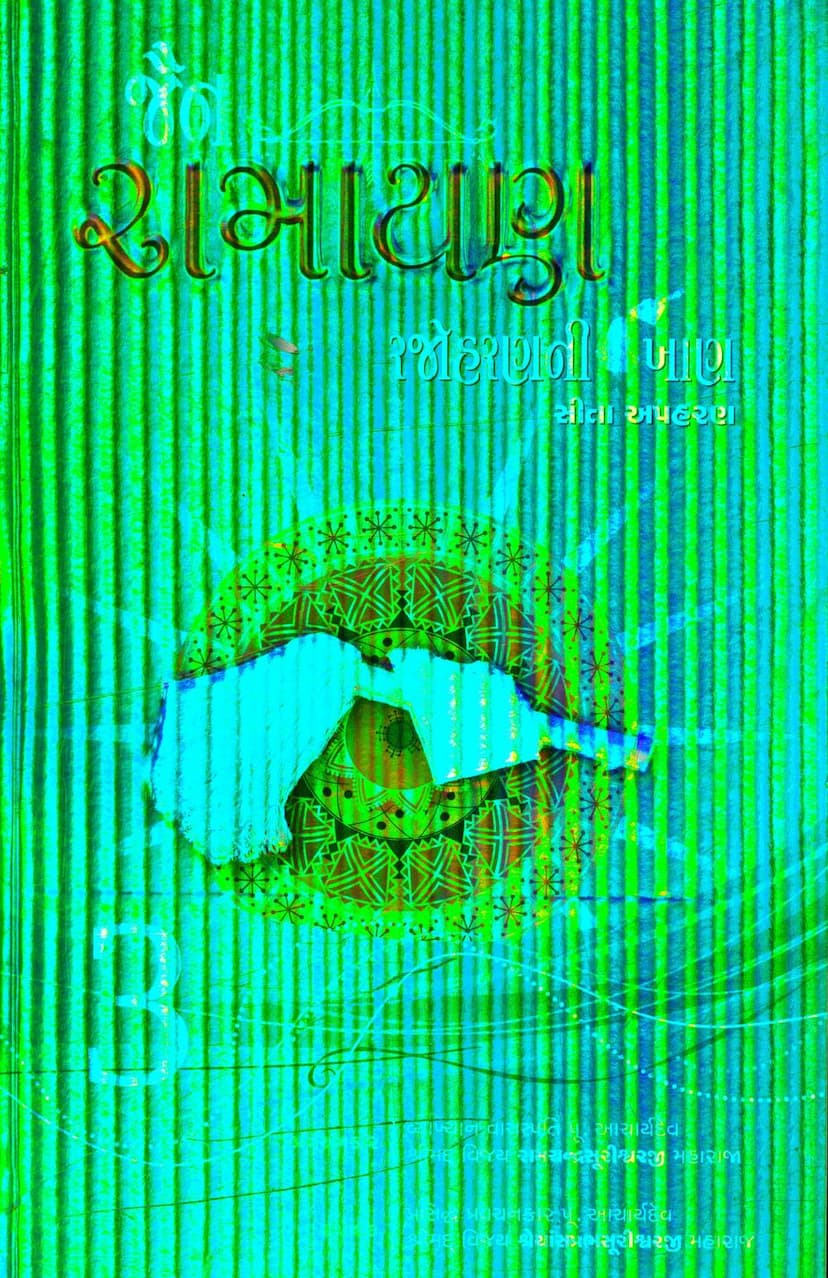Jain Ramayan Part 03
Added to library: September 2, 2025

Summary
Here's a summary of the provided Jain text, "Jain Ramayan Part 03," based on the pages you've shared:
Book Overview:
- Title: Jain Ramayan Part 03 (part of a larger series titled "Jain Ramayan: Rajoharan ni Khaan," meaning "Jain Ramayan: Mine of Purification")
- Authors: Acharya Dev Shri Ramchandrasuri, Acharya Dev Shri Shreyansprabhsuri
- Publisher: Smrutimandir Prakashan
- Catalog Link: https://jainqq.org/explore/022830/1
Key Themes and Content:
-
Jain Ramayan vs. Other Ramayanas:
- Page 2 highlights a significant difference between the Jain Ramayan and other versions. While other Ramayanas often portray Ravana as a demonic, base, lustful, and wicked figure, the Jain Ramayan presents him as a virtuous and chaste individual who abstains from transgressing against other women.
- A specific incident is mentioned where Ravan rejects the advances of Urvashi, the wife of Nalakoobar. Urvashi, attracted by Ravan's beauty and qualities, attempts to entice him by offering to open the gates of Nalakoobar's unconquerable city through her divine powers. Ravan's righteous anger and rejection of this offer are presented as evidence of his virtuous character.
-
The Core of the Jain Ramayan (as per the Introduction):
- The Jain Ramayan is based on the "Trishashthishalaka Purush Charitra" by the great Acharya Hemchandrasuri, specifically the 7th chapter which deals with the life of Ram, his marriage, and his exile.
- It emphasizes that true heaven and liberation are attainable in this very human existence if one adheres to the teachings of Lord Jineshavar. Following the divine commands leads to experiencing heaven on earth and ultimately realizing liberation.
-
Content of Part 3: "Sita Haran" (Abduction of Sita):
- Page 10 reveals that Part 3 focuses on the "Abduction of Sita" and covers the 6th and 7th chapters of the 3rd section of the Trishashthi Purush Charitra.
- The discourse begins with the concept of "Heaven and Moksha in the Human World" and touches upon the essential aspects of Jainism.
- It includes narratives about the Ram-Lakshman-Sita's journey in Dandakaranya, the story of Jatayu, King Dandak, the tale of Shabooka who sought the Surya-haas sword, Ramchandra's assistance to Sugriva, Hanuman's selection for Sita's search, and Sita's discovery in the Devaraman garden in Lanka.
-
Focus on Virtues and Ethical Teachings:
- Throughout the text, there's a strong emphasis on virtues like righteousness, chastity, adherence to dharma, the power of devotion, the importance of gratitude, the devastating nature of lust (kaam), the strength of women (Sita's unwavering resolve), the test of righteousness, and the concept of true happiness found in spiritual practice.
- The text also highlights the qualities of ideal individuals, such as their humility, forgiveness, simplicity, contentment, tolerance, and dedication to duty.
- Several chapters seem to offer moral lessons, as indicated by titles like "If you have strength, you should have forgiveness," "Ignorance is the real calamity," and "Worship without the spirit of protection is useless."
-
The Nature of Karma:
- The text delves into the concept of karma, explaining that actions (karma) have consequences. The story of the two munis (Kulbhushan and Deshbhushan) who attained Kevalgyan after facing severe trials caused by Anlaprabhadeva is used to illustrate the inescapable nature of past deeds and the importance of equanimity in the face of suffering.
- The narrative of Vasubhuti, who reincarnated in various forms due to his actions, including as a leprous king and later a demon, underscores the profound impact of karma.
-
The Role of Deities and Divine Intervention:
- The text mentions divine beings like the Yaksha Gokarna and the Vidhyadhar Ratnajati, who assist Ram and his companions. This suggests that even in the Jain narrative, divine or supernatural forces play a role in guiding or aiding the protagonists, especially when their virtues are recognized.
-
The Importance of the Guru and Jain Teachings:
- The text highlights the significance of good gurus and their teachings, as seen in the positive impact of the munis' dharma deshana on characters like Vasubhuti's soul.
- It consistently refers to the authority of Jain scriptures and Acharyas like Hemchandrasuri, indicating the text's adherence to Jain philosophical principles.
-
Critique of Modern Trends:
- The text subtly critiques contemporary societal trends, particularly those that undermine traditional values, such as the erosion of respect within families (brother-brother relationships, husband-wife, mother-in-law/daughter-in-law), the celebration of uncontrolled freedom ("swachhandata") in the name of reform, and the misinterpretation of progress leading to the destruction of ancient culture.
- It also criticizes those who question the necessity of practices like fasting or who advocate for practices that go against established Jain principles, labeling such individuals as "idam tritiyam" (belonging to a third category, implying outside the fold).
Overall Message:
The Jain Ramayan Part 03, "Sita Haran," aims to present the epic narrative of Rama from a Jain perspective, emphasizing virtues like righteousness, chastity, and adherence to dharma. It highlights the power of karma, the importance of the guru, and critiques societal deviations from Jain principles. The narrative underscores that true happiness and liberation are attained through spiritual discipline and unwavering adherence to the teachings of the Tirthankaras. It also uses the story to impart moral lessons and encourage a life of virtuous conduct and self-control.